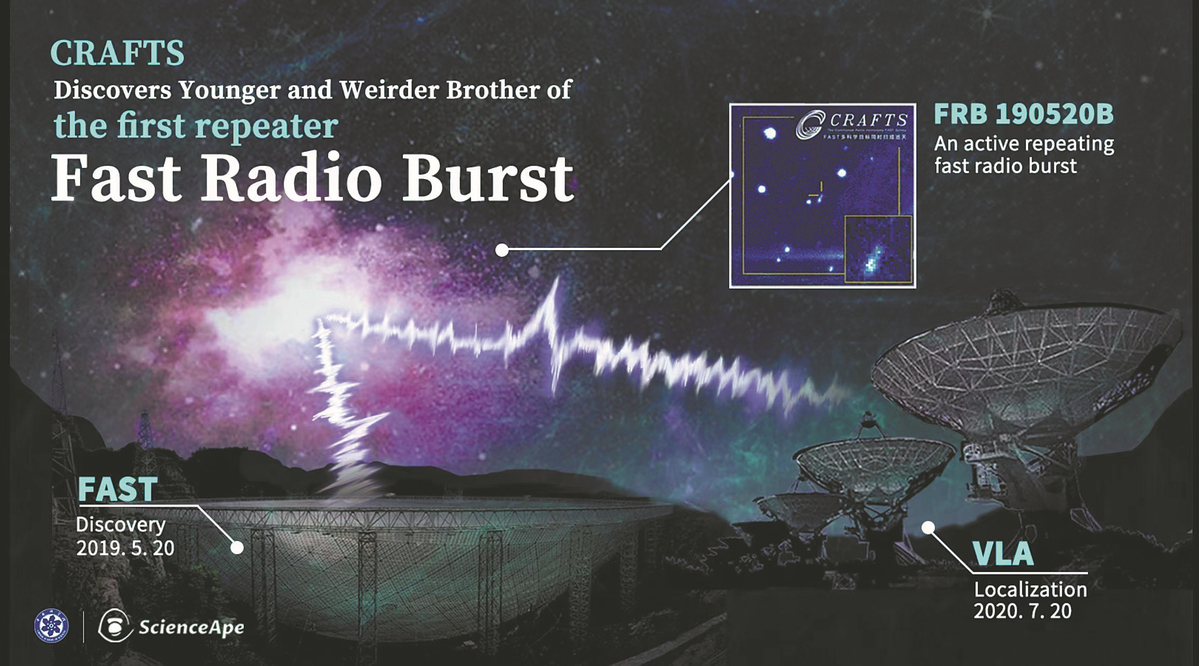


An artist's depiction demonstrates the persistent fast radio burst which was discovered using the Five-hundred-meter Aperture Spherical Radio Telescope, the world's largest single-dish telescope, in southwestern China's Guizhou province. NATIONAL ASTRONOMICAL OBSERVATORIES, CAS
An international team led by Chinese astronomers has discovered a new type of fast radio burst, extremely brief but bright flashes in the universe that mysteriously keep exploding about once every 10 to 15 minutes on average, according to a study published in the journal Nature on Wednesday.
Scientists said this extraordinary find has challenged the conventional understanding of this celestial event and may cast light on the mysteries surrounding the origin and potential evolution of these bursts, which are capable of releasing as much energy as the sun does in a year within a few thousandths of a second.
The discovery was first made using the Five-hundred-meter Aperture Spherical Radio Telescope, the world's largest single-dish telescope, located in southwestern China's Guizhou province, during the Commensal Radio Astronomy FAST Survey program.
Afterward, researchers from China, the United States, Canada, Germany, Japan and Australia, along with several observatories around the globe, collaborated to study this one-of-a-kind specimen.
Since their discovery in 2007, fast radio bursts have been a hot topic of discussion in astronomy circles. These events are notoriously difficult to detect because many originated outside of our galaxy and exist only for a very brief moment.
With the aid of highly sensitive telescopes, scientists have now discovered around 500 FRBs, most of which are one-off events. But 24 of them, for reasons that remain unknown, can repeat their explosions during a certain active phase and then take a break before the next active period.
"The fascinating part of the newly discovered fast radio burst is that it seems to be always active. It doesn't take breaks like other repeating FRBs, and it just keeps on going," said Li Di, chief scientist of FAST and the lead scientist of the international team.
The persistent fast radio burst, named FRB 20190520B, was discovered on May 20, 2019, by Niu Chenhui, a post-doctoral fellow at the National Astronomical Observatories of the Chinese Academy of Sciences.
"I find it somewhat romantic that this FRB was discovered on May 20, the unofficial day of love for Chinese netizens," Niu said. "In a way, it is like a love letter from the cosmos to the global astronomy community, enthralling us to be amazed and fall in love with what the universe has to offer."
After Niu made the initial discovery, astronomers from the California Institute of Technology and the University of Tokyo worked together to locate this unique celestial event and study its properties.
The source of FRB 20190520B was located within a dwarf galaxy about 3.3 billion light years from Earth. Scientists found that the dwarf galaxy has the most complex electromagnetic environment of all known FRB host galaxies to date.
Niu said FRB 20190520B shares many similarities with the first repeating fast radio burst discovered, called FRB20121102A, except that the former seems to have endless exuberance and resides in a more complex local environment.
"Could it be that the newly discovered repeating FRB is a younger brother of the first one? Can FRBs evolve? These questions are very interesting and may help us unravel more secrets behind these mysterious events," he said.
Scientists have hypothesized that the sources of FRBs may be remnants of supernova explosions, black holes, or an extremely magnetic and dense stellar object known as a magnetar. However, none of these candidates have been confirmed conclusively by scientists yet.
Jonathan Katz, a physics professor at the Washington University in St. Louis who was not involved in the new study, said FRB 20190520B has been shown to be immersed in a dense cloud of gas, and its persistent outbursts may be powered by a massive black hole hidden nearby that is consuming the gas at extreme speed and creating enormous heat in the process.
Duncan Lorimer, a professor at West Virginia University who discovered the first fast radio burst, said the latest discovery has challenged the conventional view of FRBs and their host environments.
Lorimer, who was not involved in the study, said he believed FRBs may have multiple sources, and as the number of discovered FRBs increases, scientists will get closer to understanding this intriguing phenomenon.
点击右上角![]() 微信好友
微信好友
 朋友圈
朋友圈

请使用浏览器分享功能进行分享
